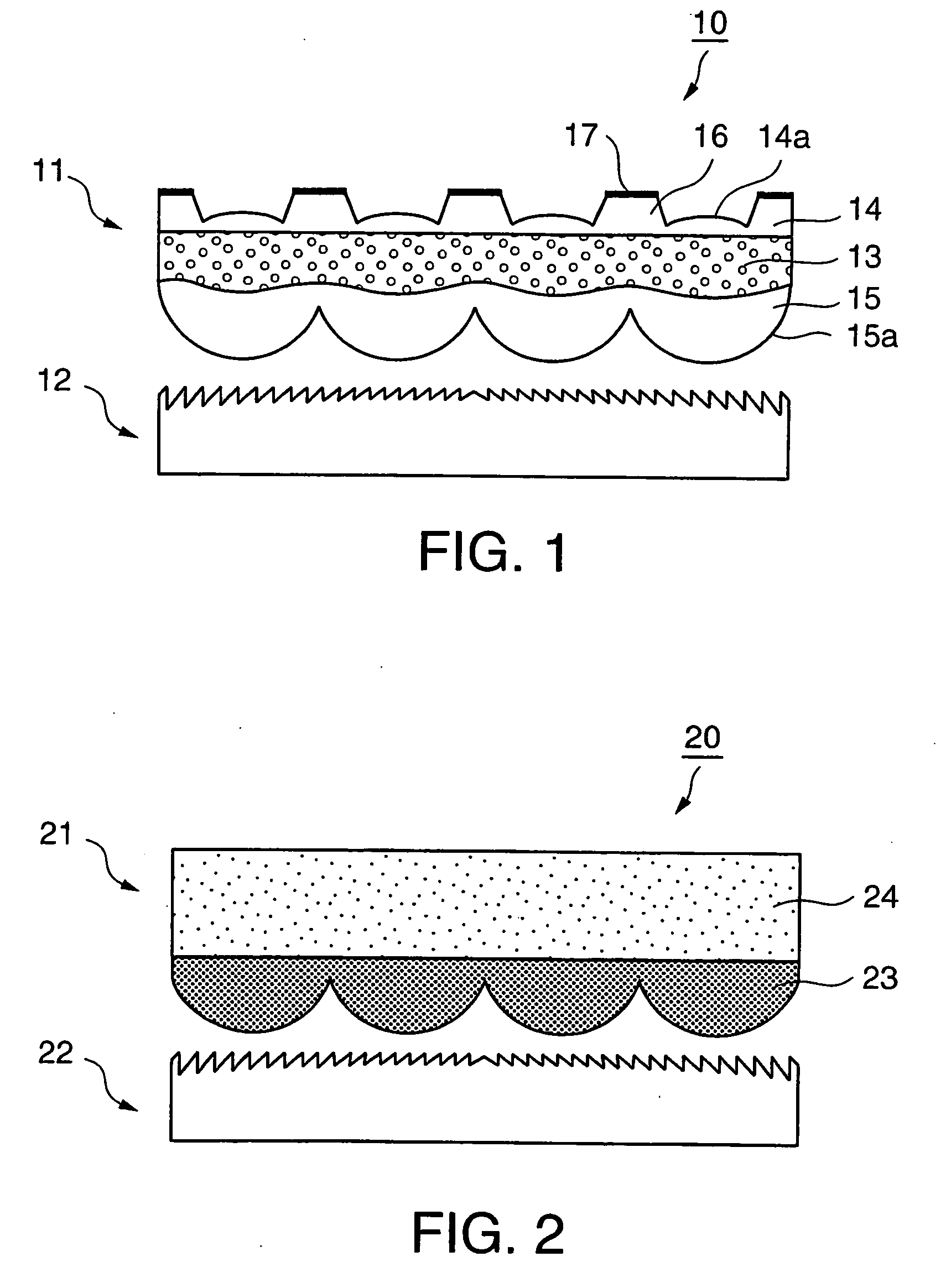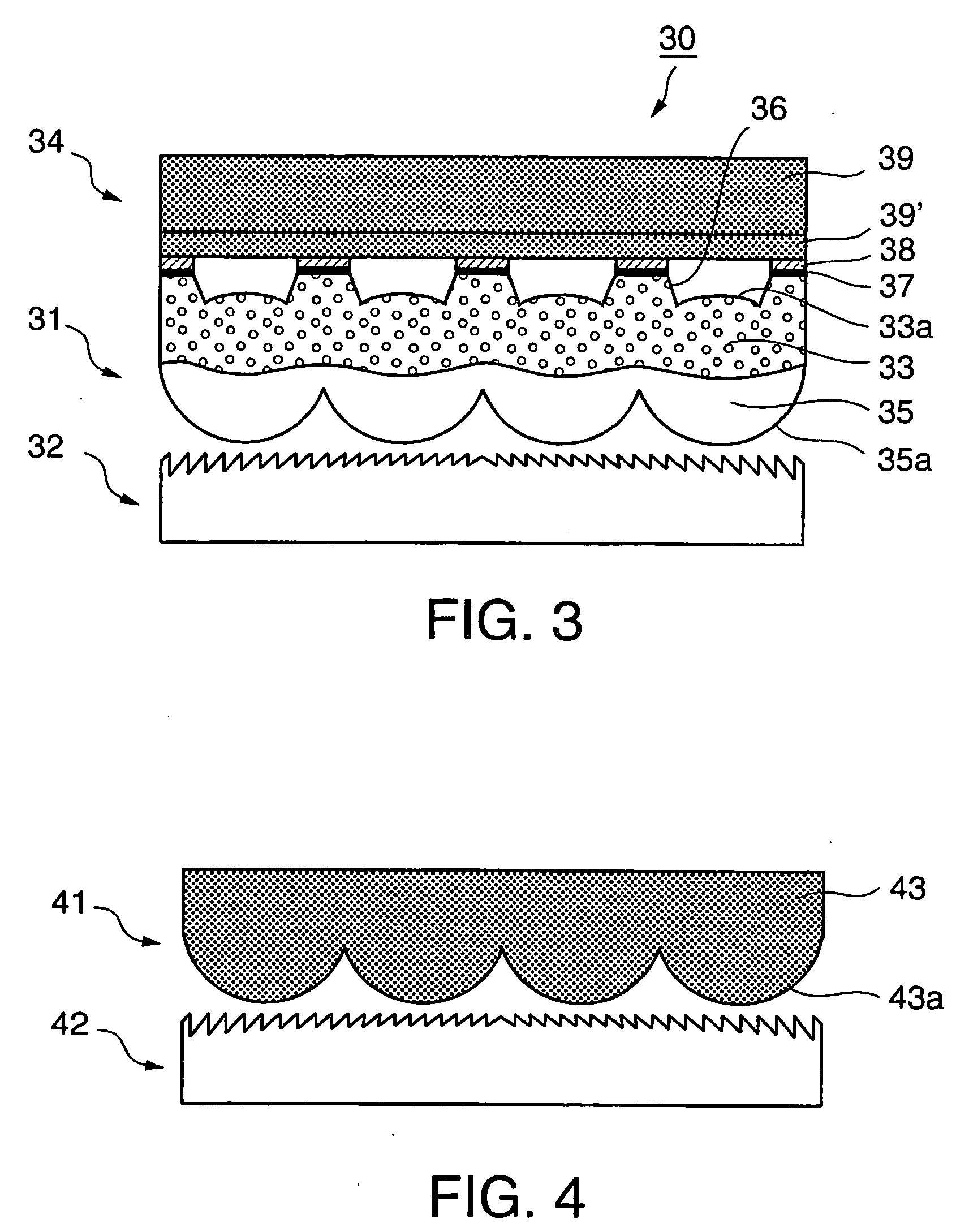Transmission type screen
a technology of transmission screen and screen body, which is applied in the direction of optics, instruments, projectors, etc., can solve the problems of glare of external light and the like occurring on the surface of the front sheet, image quality is deteriorated, image quality is greatly deteriorated, etc., and achieves the effect of convenient manufacturing and desired optical performan
- Summary
- Abstract
- Description
- Claims
- Application Information
AI Technical Summary
Benefits of technology
Problems solved by technology
Method used
Image
Examples
example 1
[0081] A transmission type screen corresponding to that shown in FIG. 1 was manufactured as a transmission type screen according to example 1.
[0082] Specifically, a 52-inch double-sided lenticular lens sheet having a light diffusion layer as an intermediate layer as well as clear layers on the front and back surfaces thereof was manufactured by the multi-layer extrusion molding method. The light diffusion layer was composed of an acrylic resin (refraction factor: 1.49) as a base member which contained therein, as a light diffusion agent, 2 wt % of beads composed of a spherical bridged acryl-styrene copolymer resin having an average particle size of 20 μm and a refraction factor of 1.51 as well as 3.5 wt % of spherical bridged styrene beads having an average particle size of 9 μm and a refraction factor of 1.59. The front and back clear layers were composed of a transparent acrylic resin, and lenticular lens groups extending in a vertical direction were formed on the light source si...
example 2-1
[0086] A transmission type screen corresponding to that shown in FIG. 2 was manufactured as a transmission type screen according to example 2-1.
[0087] Specifically, a 60-inch single-sided lenticular lens sheet, which had light diffusion layers on the viewer side and on the light source side, respectively, was manufactured by the multi-layer extrusion molding method. The viewer-side light diffusion layer was composed of an acrylic resin (refraction factor: 1.49) as a base member which contained therein, as a light diffusion agent, 0.4 wt % of beads composed of a spherical bridged acryl-styrene copolymer resin having an average particle size of 5 μm and a refraction factor of 1.51. Further, the light source side light diffusion layer was composed of an acrylic resin (refraction factor: 1.49) as a base member which contained therein, as a light diffusion agent, 5.5 wt % of spherical bridged styrene beads having an average particle size of 9 μm and a refraction factor of 1.59. A lentic...
example 2-2
[0091] A transmission type screen corresponding to that shown in FIG. 4 was manufactured as a transmission type screen according to example 2-2.
[0092] Specifically, a 60-inch single-sided lenticular lens sheet having a light diffusion layer was manufactured by the cast molding method. The light diffusion layer was composed of an acrylic resin (refraction factor: 1.49) as a base member which contained therein, as a light diffusion agent, 2.5 wt % of beads composed of a spherical bridged acryl-styrene copolymer resin having an average particle size of 13 μm and a refraction factor of 1.53 as well as 5 wt % of spherical bridged styrene beads having an average particle size of 9 μm and a refraction factor of 1.59. A lenticular lens group, which extended in the vertical direction at a pitch of 0.15 mm, was formed on the light source side surface of the light diffusion layer.
[0093] The 60-inch transmission type screen was assembled by further disposing a Fresnel lens sheet having the sa...
PUM
 Login to View More
Login to View More Abstract
Description
Claims
Application Information
 Login to View More
Login to View More - R&D
- Intellectual Property
- Life Sciences
- Materials
- Tech Scout
- Unparalleled Data Quality
- Higher Quality Content
- 60% Fewer Hallucinations
Browse by: Latest US Patents, China's latest patents, Technical Efficacy Thesaurus, Application Domain, Technology Topic, Popular Technical Reports.
© 2025 PatSnap. All rights reserved.Legal|Privacy policy|Modern Slavery Act Transparency Statement|Sitemap|About US| Contact US: help@patsnap.com



